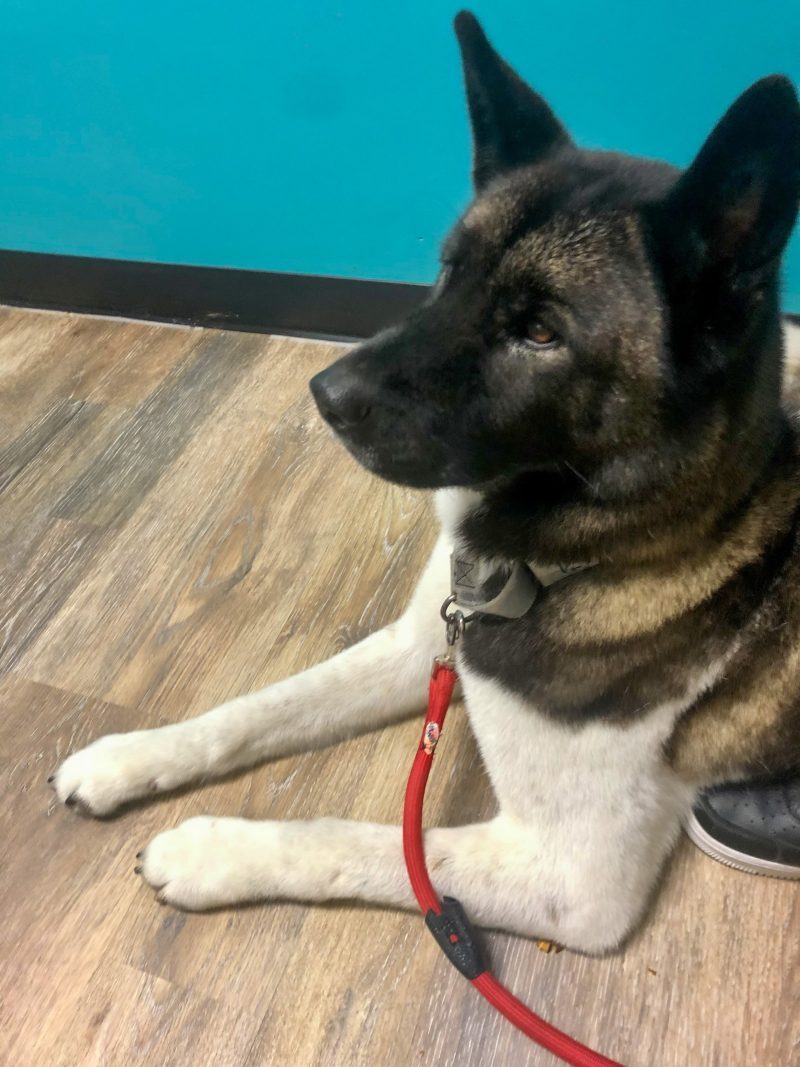If you’re wondering how much does a vet visit cost for a sick dog, this guide will help you estimate your costs. A few factors come into play when determining vet costs, which we’ll go over. Your type of vet visit, the kind of vet you see, and your location influence your total vet bill.
As the owner of a big dog in an expensive city, I understand the anxiety of worrying about vet costs. Since my current dog has had some major surgeries – including cancer surgery, eye surgery, and bloat surgery, I have unfortunately had firsthand experience with high vet costs. I hope these tips will help you calculate how much you need to cover your dog’s vet visits and plan ahead to budget for future visits. I’ve learned through experience from my rescue dogs how much vet bills can be, and I hope to help you avoid some of the mistakes I’ve made with financing vet bills.
Related Post: How Much Does Dog Food Cost Per Month? A Breakdown
Vet Costs: What to Expect
So, how much does a vet visit cost for a sick dog? Generally, a vet visit can range from $100 to over $1000, but a few factors can help narrow the cost range. Consider these aspects before calculating your total estimated vet cost:
Location
Your geographic location dictates the general cost of services in your area. If you live in an expensive city like me (I’m in NYC), you’ll pay up to two or three times more than people in lower-cost towns and smaller cities. From my experience, a vet visit in big U.S. cities can cost between $250 and $500, and this usually covers the office visit and perhaps one test, such as a urine or simple blood test.
On the other hand, smaller towns and cities may charge between $75 and $200 for a vet visit. I have taken my dogs to vets in St. Louis, and the vets cost around $100 to $150 for a visit, which is about one-third the cost of what I pay for a vet visit in NYC.
Type of Visit
Your reason for visiting the vet will also determine the price you pay. If you get a check-up and the vet can tell by examining your dog what is wrong (an ear infection, for instance), you will pay less. On the other hand, if your dog has a more severe or complex medical condition that requires diagnostic testing like bloodwork, X-rays, or other imaging tests, your vet bill will be much higher.
For a simple sick visit for something common like an ear infection or UTI, you will be charged for the office visit, the cost of any diagnostic tests, and any medication the doctor prescribes. A simple sick visit may range from $100 in cheaper places to $500 in more expensive cities.
Type of Vet
The type of vet you visit will also influence your total cost. For instance, you will have the lowest prices if you go to a low-cost clinic or a non-profit vet such as an ASPCA vet. You may pay between $75 and $300 for a low-cost vet if your dog has a common illness that does not require extensive treatment.
Corporate vet chains such as Bond Vet tend to be higher priced than small, family-owned vet practices. I have paid up to $700 at corporate vets for routine exams and blood work and have since found less expensive vets at small, local clinics.
Specialist vets and emergency vet hospitals usually cost the most as they require extensive training and expertise. I have taken my dog to an eye specialist vet in NYC for a scratched cornea. Her procedure was $1500, which is a lot, but the vet did an excellent job, preventing me from going to more vets. (Originally I went to a general vet and they could not treat her successfully).
There is a wide range of costs for taking your dog to the vet for medical issues, and the final price tag depends on your location, the type of visit, and the vet you choose.
How Much Does a Vet Visit Cost for a Sick Dog?
As you can see, many factors influence the price of your vet visit. So, when you’re trying to determine how much does a vet visit cost for a sick dog, the best way to find out is to call the vet and ask directly before going in. Ask about the office exam fee and see if you can get a general estimate of the costs if you have an idea of what is wrong with your dog.
If you’ve been to a vet in the past, that’s one of the best ways to estimate your costs for a visit. Vets will give you a printout of costs when you pay your bill, so if you still have your past receipts – in paper or email form- you can see the fee for office visits.
Generally, you can expect to pay between $100 to $300 to take your dog to a vet for an illness or injury. This does not include diagnostic testing, medications, and treatments. Since our pets cannot talk, vets sometimes have to do several tests to determine the problem, which can be costly, adding hundreds of dollars to the bill.
In addition, if you’re in an emergency situation and have to go to an all-night vet hospital, you will likely pay over $1,000 for diagnostics and treatment. The bill can go much higher for emergency situations and surgeries. When my dog had bloat, it was nighttime, and we went to an emergency vet in Brooklyn. The cost was over $8,500 to admit her for urgent surgery. Since bloat is life-threatening, I had to act fast, and luckily, I was able to cover the cost on a credit card and then submit a claim to my vet insurance for partial reimbursement.
Vet Financing Options
If you find yourself in a stressful situation where your dog needs urgent medical care and you don’t have enough money to cover it, there are options for financing. Most vets will list their funding and payment options on their websites, which is good to know before going. Here are some standard financing options to help pay for vet bills:
CareCredit
CareCredit is a credit card designed for pet and human medical costs. You can apply for the card and use it for emergency vet situations. Just watch out, as the interest rates can be high, as with many credit cards.
CareCredit may offer you 0 percent financing if you pay the entire balance back in a specified amount of time, but be sure to learn the terms, as people who do not pay the total balance within the agreed-upon time get charged 26.99% annual percentage rate on every cent that was financed with the card, according to NerdWallet.
You may qualify for longer-term financing for lower interest rates if your dog needs an expensive surgery. See if your vet takes CareCredit and then learn about the rates and financing options before applying if you decide to go this route.
Pet Insurance
Pet insurance is another way to finance your pet’s vet visit. Pet insurance companies have varying benefits, rates, and coverage, which could be a whole article. I only got pet health insurance in the last year (MetLife) and have been disappointed that it hasn’t covered our sick visits yet. Still, I hope it will reimburse me for my dog’s bloat surgery. I will update this once I see how MetLife handles the bloat costs.
When choosing pet insurance, read the terms and ask your vet if they have any restrictions on insurance. Many vets do not take insurance as a form of payment. However, you can usually submit your paid vet invoices to your insurance company for reimbursement or to count toward your deductible.
Pet health insurance can be a lifesaver for expensive, critical surgeries so your finances don’t get destroyed. I highly recommend getting pet insurance for help with costly emergencies and surgeries that can arise over the course of your pet’s life. Remember that you will most likely still have to pay for all your vet bills upfront and then submit your insurance claims before getting reimbursed.
Savings Account
A savings account is another way to pay your dog’s vet bills. With the high cost of vets and pet care, I recommend starting a savings account for your pup, even if you also have pet insurance. Putting aside a little money each month in the savings account can help you prepare for an emergency. No one wants to give up their dog due to unforeseen medical expenses, and a savings account can help you take good care of your dog through sickness and health.
Crowdfunding
GoFundMe and Waggle are popular crowdfunding options pet parents use to help finance expensive surgeries and treatments. Waggle is specifically for pets and channels funds directly to verified veterinarians for a pet’s care.
Vet Bill Grants
Another option is to apply for vet bill grants. These are not guaranteed, but they’re worth checking out if you have exhausted your resources. A variety of nonprofits offer assistance to approved applicants who have pending surgeries or medical treatments for their dogs.
Here are some resources to help you find vet grants. Keep in mind that many require you to apply before getting treatment, so check out the list before going to the vet:
The Animal Foundation offers a directory of vet assistance programs and grants that can help pet owners cover the costs of vet treatments.
Red Rover provides grants of up to $200 to cover urgent veterinary care for pets.
Voices for the Animals Foundation has a Helping Friends program that assists seniors, people with disabilities, terminal illnesses, or fixed incomes to take care of their pets and vet expenses.
Local animal rescues and shelters can often direct you to more resources. They will have knowledge of low-cost vet clinics and possibly grants in your area.
Affordable Vet Care
Many pets end up in shelters because families can no longer afford them. If you need assistance with vet bills, food, or other costs, here are some resources to check out:
Pet Help Finder locates financially friendly vets in your area. Simply enter your city, state, and zip code to see affordable vets near you.
Veterinary colleges often have low-cost vet programs and specialists who can provide vet care for less than regular vets.
Pet Food Pantry – Pet Help Finder can also connect you with local pet food pantries and services to assist with feeding your pet.
When you’re calculating how much does a vet visit cost for a sick dog, there are a few factors to consider, including your location, type of vet visit, and your pet’s state of health. I hope these resources help to understand the general costs of sick vet visits and prepare for future visits. Take care – of yourself and your pup!
Related Posts: How Much Does Dog Food Cost Per Month? A Breakdown, Dog-Friendly Shopping Guide




